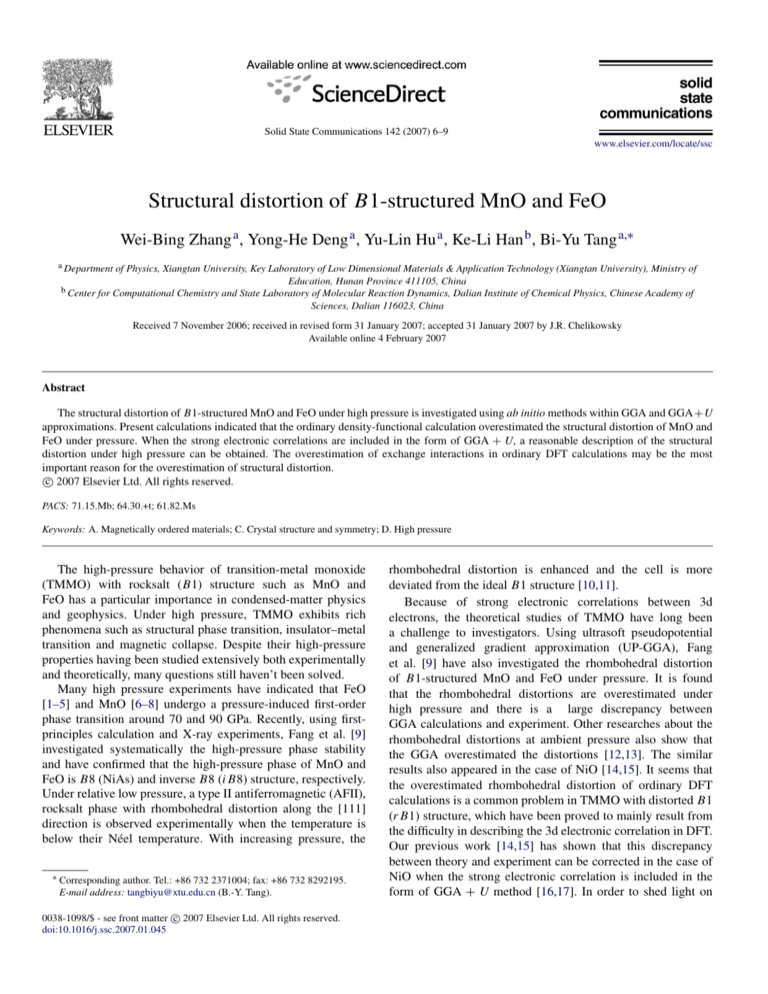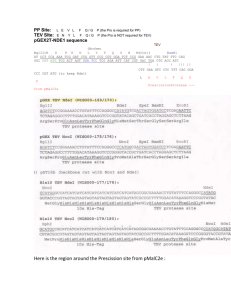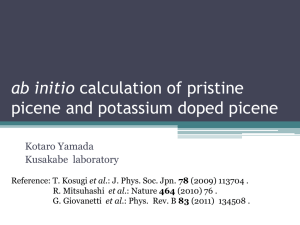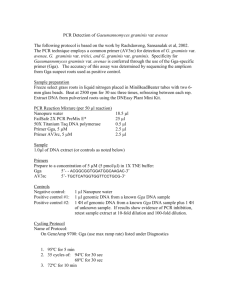
Solid State Communications 142 (2007) 6–9
www.elsevier.com/locate/ssc
Structural distortion of B1-structured MnO and FeO
Wei-Bing Zhang a , Yong-He Deng a , Yu-Lin Hu a , Ke-Li Han b , Bi-Yu Tang a,∗
a Department of Physics, Xiangtan University, Key Laboratory of Low Dimensional Materials & Application Technology (Xiangtan University), Ministry of
Education, Hunan Province 411105, China
b Center for Computational Chemistry and State Laboratory of Molecular Reaction Dynamics, Dalian Institute of Chemical Physics, Chinese Academy of
Sciences, Dalian 116023, China
Received 7 November 2006; received in revised form 31 January 2007; accepted 31 January 2007 by J.R. Chelikowsky
Available online 4 February 2007
Abstract
The structural distortion of B1-structured MnO and FeO under high pressure is investigated using ab initio methods within GGA and GGA+U
approximations. Present calculations indicated that the ordinary density-functional calculation overestimated the structural distortion of MnO and
FeO under pressure. When the strong electronic correlations are included in the form of GGA + U, a reasonable description of the structural
distortion under high pressure can be obtained. The overestimation of exchange interactions in ordinary DFT calculations may be the most
important reason for the overestimation of structural distortion.
c 2007 Elsevier Ltd. All rights reserved.
PACS: 71.15.Mb; 64.30.+t; 61.82.Ms
Keywords: A. Magnetically ordered materials; C. Crystal structure and symmetry; D. High pressure
The high-pressure behavior of transition-metal monoxide
(TMMO) with rocksalt (B1) structure such as MnO and
FeO has a particular importance in condensed-matter physics
and geophysics. Under high pressure, TMMO exhibits rich
phenomena such as structural phase transition, insulator–metal
transition and magnetic collapse. Despite their high-pressure
properties having been studied extensively both experimentally
and theoretically, many questions still haven’t been solved.
Many high pressure experiments have indicated that FeO
[1–5] and MnO [6–8] undergo a pressure-induced first-order
phase transition around 70 and 90 GPa. Recently, using firstprinciples calculation and X-ray experiments, Fang et al. [9]
investigated systematically the high-pressure phase stability
and have confirmed that the high-pressure phase of MnO and
FeO is B8 (NiAs) and inverse B8 (i B8) structure, respectively.
Under relative low pressure, a type II antiferromagnetic (AFII),
rocksalt phase with rhombohedral distortion along the [111]
direction is observed experimentally when the temperature is
below their Néel temperature. With increasing pressure, the
∗ Corresponding author. Tel.: +86 732 2371004; fax: +86 732 8292195.
E-mail address: tangbiyu@xtu.edu.cn (B.-Y. Tang).
c 2007 Elsevier Ltd. All rights reserved.
0038-1098/$ - see front matter doi:10.1016/j.ssc.2007.01.045
rhombohedral distortion is enhanced and the cell is more
deviated from the ideal B1 structure [10,11].
Because of strong electronic correlations between 3d
electrons, the theoretical studies of TMMO have long been
a challenge to investigators. Using ultrasoft pseudopotential
and generalized gradient approximation (UP-GGA), Fang
et al. [9] have also investigated the rhombohedral distortion
of B1-structured MnO and FeO under pressure. It is found
that the rhombohedral distortions are overestimated under
high pressure and there is a large discrepancy between
GGA calculations and experiment. Other researches about the
rhombohedral distortions at ambient pressure also show that
the GGA overestimated the distortions [12,13]. The similar
results also appeared in the case of NiO [14,15]. It seems that
the overestimated rhombohedral distortion of ordinary DFT
calculations is a common problem in TMMO with distorted B1
(r B1) structure, which have been proved to mainly result from
the difficulty in describing the 3d electronic correlation in DFT.
Our previous work [14,15] has shown that this discrepancy
between theory and experiment can be corrected in the case of
NiO when the strong electronic correlation is included in the
form of GGA + U method [16,17]. In order to shed light on
7
W.-B. Zhang et al. / Solid State Communications 142 (2007) 6–9
experimental results and clarify the underlying mechanism, in
the present study, we investigate the structural properties of B1structured FeO and MnO under high pressure based on density
function theory within GGA and GGA + U methods.
All calculations in this paper have been performed with
Vienna Ab initio Simulation Package (VASP) [18–20], a
generalized gradient approximation [21] was chosen for the
exchange correlation functional, and the spin interpolation of
Vosko et al. [22] was also used. The interaction between
ions and valence electrons was described by the projector
augmented-wave (PAW) method [23]. The Kohn–Sham
equations were solved via iterative matrix diagonalization
based on the minimization of the norm of the residual vector to
each eigenstate and optimized charge- and spin-mixing routines
[24–26]. To take into account the electronic correlation, a
simple rotationally invariant DFT + U version proposed by
Dudarev et al. [27–29] was used. In this method, parameters
U and J represented on-site Coulomb interaction energy and
exchange energy, respectively. The parameters U and J did not
enter separately, only the difference U − J was meaningful. J
was kept fixed to 1 eV in the present calculation. Because of
increasing screening, the electronic correlation is expected to
become weak and U parameter should be pressure dependent.
Recently, a LDA + U approach has been implemented in the
plane wave pseudopotential method [30], where U is calculated
in an internally consistent way and the change of U induced
by pressure and impurity can also be considered. This novel
method has been very successful in describing FeO [30] and
magnesiowüstite [31] under pressure. The results indicate that
the high-pressure properties of strongly correlated systems
depend crucially on the pressure dependence of U and the more
accurate description should take into account the change of
U . However, the change of U is usually very small for many
systems under the considered pressure range and is expected
to have a minor influence on the structural properties. So the
variation of U can be neglected and U has been approximately
set as a constant, as have many authors in other systems such
as LaMnO3 [32] and GaN [33]. This is also a common practice
until now, and a reasonable result can be given. In the present
study, GGA + U method implemented in VASP code was used
with U = 7 eV for MnO [27] and a U = 6 eV for FeO [34],
which are taken from constrained LDA computations.
The results reported in this paper were carried out on
a rhombohedral antiferromagnetic supercell including two
formula unit cells. A plane-wave basic set expanded in energy
cutoff of 600 eV and k point sampling with a mesh of points 8×
8 × 8 generated by the scheme of Monkhorst and Pack [35] can
ensure the convergence accuracy with total energies difference
less than 3 meV/atom. The unit cell shape optimizations for
each volume were performed using the conjugate gradient
method and a Gaussian smearing with a width of 0.2 eV.
Forces acting on atoms and stress tensors on unit cells were
used in the optimization process. For total energy calculations,
the integration over the Brillouin zone was performed using
the linear tetrahedron method with Blöchl corrections [36–
38]. The calculated total energies as a function of volume
were fitted to the Murnaghan equation of state (EOS) [39] to
Table 1
Equation-of-state parameters and magnetic moments of MnO and FeO at
ambient pressure
´
a (Å)
B0
B00
Moment (µ B )
MnO
GGA
GGA + U
Fang et al.
Experiment
4.433
4.496
4.46
4.435a
152
150
157
151b ,162c
3.13
3.59
3.23
3.6,4.8
4.304
4.684
4.47
4.58d ,4.79e
FeO
GGA
GGA + U
Fang et al.
Experiment
4.268
4.333
4.28
4.334f
169
173
180
142f ,180g
3.59
3.74
3.55
4.9
3.384
3.754
3.46
4.2h
a
b
c
d
e
f
g
h
[40].
[41].
[42].
[43].
[44].
[45].
[46].
[47].
obtain equilibrium volume V0 , bulk modulus B0 and its pressure
derivatives B00 .
First, we give the equilibrium properties of FeO and MnO
at ambient pressure. Recently, Cococcioni et al. [30] suggested
a broken symmetry phase as ground state of FeO, which has
a lower energy than the standard structure and also displays
the correct pressure dependence of the rhombohedral angle.
However, the validity of the new phase needs to be confirmed
further both theoretically and experimentally. Thus, the present
results including bulk properties and structural distortion of
FeO are still based on B1 (r B1) structure. As shown in Table 1,
using PAW-GGA, the calculated lattice parameter for MnO and
´ and 4.268 Å
´ which are in good agreement with
FeO is 4.433 Å
experimental result [40,45]. Whereas the GGA + U seems to
give relatively larger results than GGA calculation, the obtained
´ and 4.333 Å,
´ respectively. One also
lattice parameter is 4.496 Å
can find from the table that the calculated bulk modulus and
pressure derivative of bulk modulus using both methods are also
quite reasonable.
As shown above, GGA can successfully predict bulk
properties, but the ordinary DFT calculation is known to be not
powerful enough to describe the bandgaps of Mott insulators.
For MnO, the GGA predicts that it is an insulator with bandgap
about 1.3 eV, which is largely underestimated. For FeO, GGA
even predicts that its ground state is metallic, in contrast
with the experimental observation. When the strong electronic
correlations are included, the correct insulator ground state
can be obtained. A bandgap about 3.0 and 1.85 eV for MnO
and FeO appears in GGA + U calculation, which is also
similar to other calculations. The magnetic moments are also
underestimated in GGA calculations. Present GGA calculations
give 4.304µ B and 3.384µ B for MnO and FeO, which are much
smaller than experiment. Using GGA + U, the obtained values
are 4.684µ B and 3.76µ B , respectively, which also agree with
other calculations [48,9]. It should be pointed out that the more
proper description of the ground state needs a treatment of
spin–orbit coupling.
8
W.-B. Zhang et al. / Solid State Communications 142 (2007) 6–9
The structural distortion is very important for the AFII
r B1 phase of TMMO. As shown above, MnO and FeO are
observed to be compressed and stretched respectively. At
ambient pressure, present results show that GGA and GGA + U
can predict the correct sign of the rhombohedral distortion,
but GGA overestimates the rhombohedral distortion for both
oxides. Using GGA, the obtained rhombohedral distortion c/a
at experimental lattice parameters are 2.35244 and 2.83933
for MnO and FeO. The experimental rhombohedral distortion
of MnO is 2.40984 (α = 60.72◦ ) [49]. For FeO, the value
extrapolated from the experimental strain as a function of
vacancy concentration suggests the value of c/a is 2.54037
(α = 58.40◦ for stoichiometric FeO) [50]. This overestimated
structural distortions also appear in the Fang et al. [9] and Pask
et al.’s calculations [13]. The present GGA + U calculations
give the value of c/a as 2.41501 and 2.57079 respectively,
which are in good agreement with experimental results. As
shown above, although GGA overestimated the structural
distortion of TMMO, it can give a reasonable lattice parameter
and bulk modulus. The reason may be lattice parameter and
bulk modulus are determined by the total energies through
EOS, whereas structural distortion is decided by the magnetic
exchange interactions. Energy is an integral quantity, whereas
it is well known that a magnetism related quantity is not able to
be described accurately by ordinary DFT calculation.
Now we turn our attention to the structural distortion under
high pressure. It should be noticed that MnO and FeO may
undergo a pressure-induced structural phase transition around
70 GPa and 90 GPa, respectively. Above this transition pressure, the phase structure of MnO and FeO should be B8 and
inverse B8 structure. In our study, the structure is supposed
to keep in the B1 structure and other high pressure structure
is beyond the scope of the present study. Fig. 1 shows the
cell volume dependence of structural distortion of MnO. As
shown in the figure, both calculations predict the correct sign of
c/a under pressure and can also give the reasonable tendency
of the change of distortions with decreasing volume. Consistent with experiment [10,11], the structural distortion predicted
with GGA and GGA + U method increases with decreasing
cell volumes. However, present PAW-GGA and Fang et al.’s
UP-GGA calculations underestimated axial ratio c/a under the
entire pressure region, which indicates the GGA has difficulties
in describing the structural distortion. It’s very clearly seen that
the GGA + U gives a more reasonable description for structural
distortion under high pressure. It should be noticed that when
the volume of cell is lowered to a smaller value (16.0 Å3 for
GGA and 13.718 Å3 for GGA + U), the c/a shows a significant
change in both GGA and GGA + U calculation which indicate
there is a phase transition in MnO under high pressure. However, the continuous changes in the figure indicate that there is
no phase transition occurred in the considered volume range.
The calculated and experimental structural distortions of
FeO under pressure are shown in Fig. 2. Similar to the case
of MnO, UP-GGA and PAW-GGA cannot give a reasonable
description for structural distortion. Only the GGA + U can
reproduce the reasonable experimental results [49]. However,
it is noticed that in the case of FeO, c/a is larger than the
Fig. 1. The calculated rhombohedral distortion versus volume for AF r B1
structured MnO, and comparison with experimental results and Fang et al.’s
GGA calculation (Ref. [9]). Exp. 1 and Exp. 2 come from
√ Ref. [10] and
Ref. [49]. The value of c/a shown in the figure is divided by 6.
Fig. 2. The calculated rhombohedral distortion versus volume for AF r B1
structured FeO, and comparison with experimental results and Fang et al.’s
GGA calculation. Exp. 1 and Exp. 2 come from
√ Ref. [11] and Ref. [50]. The
value of c/a shown in the figure is divided by 6.
ideal B1 structure and increases with pressure under the entire
pressure region, whereas in the case of MnO, the value of
c/a is smaller than the ideal B1 structure and decreases with
pressure. In fact, both MnO and FeO have a similar tendency.
With increasing pressure, the c/a of both monoxides deviates
from B1 structure more and more largely. Recently, Cococcioni
et al. have investigated the structural distortion of FeO using
GGA and LDA + U method and also found GGA overestimates
the rhombohedral distortion and its pressure dependence. Based
on the B1 structure, they did not give a correct distortion
using their LDA + U method. And they suggested that the
correct pressure dependence of the rhombohedral angle could
be obtained based on a new broken symmetry phase [30].
However, using GGA + U methods, we reproduced well
experimental results based on conventional B1 phase. It seems
that different functional forms may play a very important role
in calculations about structural distortion of FeO.
The underlying mechanism of structural distortion below TN
for TMMO has been discussed by many authors since the late
1950s [51,52]. It’s argued that the weak NN (nearest-neighbor)
W.-B. Zhang et al. / Solid State Communications 142 (2007) 6–9
interaction plays a decisive role in the structural distortion. Base
on distance dependent NN interactions, Rodbell and Owen [53]
used a molecular-field approach to derive an expression for
distortion, which shows the rhombohedral distortion explicitly
depends on the NN interactions. Recently, Pask et al. [13]
investigated the exchange constants of MnO and also find
that the distortion can be understood with distance dependent
NN interactions. However, their obtained exchange constant
is significantly larger than experimental data. It’s also noticed
that the overestimated exchange constant also appears in other
DFT calculation (a detailed comparison of theoretical and
experimental results about the exchange constant of MnO can
be found in Ref. [48]). Our previous work about NiO [16,
17] also shows that the direct magnetic interactions are
overestimated hugely in the case of ordinary DFT calculation,
which leads to a large deviation of structure distortion from
experimental results. Thus, the suggested mechanism for the
overestimation of structural distortion is the overestimation of
NN magnetic exchange interaction. When the strong electronic
correlations were included in the form of GGA+U, much better
description of structural distortion under the pressure range
could be obtained.
In summary, we have investigated the structural distortion
of B1-structured MnO and FeO under high pressure using
GGA and GGA + U methods. Although GGA gives a
reasonable bulk property, it gives an incorrect description of
the electronic structure and overestimates structural distortions
of both oxides. Only when the strong electronic corrections are
included, the reasonable ground state and structural distortion
can be obtained. Under high pressure, the overestimated
structural distortion in GGA calculation still exists. Using
GGA + U, the structural distortions under high pressure are
in good agreement with experiment due to the reasonable
description of NN magnetic exchange interaction. These results
suggest that the structural distortions are driven by magnetic
exchange interaction and the strong electronic correlation plays
a very important role in properties of TMMO even under high
pressure. DFT + U can give a much better description of
strongly correlated system even under high pressure.
Acknowledgement
This work is supported by the Open Project Program of
Key Laboratory of Low Dimensional Materials & Application
Technology (Xiangtan University), Ministry of Education
(KF0504).
References
[1] R. Jeanloz, T.J. Ahrens, Geophys. J. R. Astron. Soc. 62 (1980) 505.
[2] T. Yagi, K. Fukuoka, H. Takei, Y. Syono, Geophys. Res. Lett. 15 (1988)
816.
[3] T. Yagi, T. Suzuki, S. Akimoto, J. Geophys. Res. 90 (1985) 8784.
[4] H.K. Mao, et al., Phys. Earth Planet. Inter. 96 (1996) 135.
9
[5] Y.W. Fei, H.K. Mao, Science 266 (1994) 1678.
[6] R. Jeanloz, A. Rudy, J. Geophys. Res. 92 (1987) 11433.
[7] Y. Noguchi, K. Kusaba, K. Fukuoka, Y. Syono, Geophys. Res. Lett. 23
(1996) 1469.
[8] T. Kondo, T. Yagi, Y. Syono, T. Kikegawa, O. Shimomura, Rev. High
Pressure Sci. Technol. 7 (1998) 148.
[9] Z. Fang, I.V. Solovyev, H. Sawada, K. Terakura, Phys. Rev. B 59 (1999)
762.
[10] T. Kondo, T. Yagi, Y. Syono, T. Kikegawa, O. Shimomura, Rev. High
Pressure Sci. Technol. 7 (1998) 148.
[11] T. Yagi, T. Suzuki, S. Akimoto, J. Geophys. Res. 90 (1985) 8784.
[12] D.G. Isaak, R.E. Cohen, M.J. Mehl, D.J. Singh, Phys. Rev. B 47 (1993)
7720.
[13] J.E. Pask, D.J. Singh, I.I. Mazin, C.S. Hellberg, J. Kortus, Phys. Rev. B 64
(2001) 024403.
[14] T. Eto, S. Endo, M. Imai, Y. Katayama, T. Kikegawa, Phys. Rev. B 61
(2000) 14984.
[15] T. Sasaki, Phys. Rev. B 54 (1996) R9581.
[16] W.-B. Zhang, Y.-L. Hu, K.-L. Han, B.-Y. Tang, Phys. Rev. B 74 (2006)
054421.
[17] W.-B. Zhang, Y.-L. Hu, K.-L. Han, B.-Y. Tang, J. Phys.: Condens. Matter
18 (2006) 9691.
[18] G. Kresse, J. Furthmüller, Phys. Rev. B 54 (1996) 11169.
[19] G. Kresse, J. Furthmüller, Comput. Mater. Sci. 6 (1996) 15.
[20] G. Kresse, D. Joubert, Phys. Rev. B 59 (1999) 1758.
[21] J.P. Perdew, J.A. Chevary, S.H. Vosko, K.A. Jackson, M.R. Pederson, D.J.
Singh, C. Fiolhais, Phys. Rev. B 46 (1992) 6671.
[22] S.H. Vosko, L. Wilk, M. Nusair, Canad. J. Phys. 58 (1980) 1200.
[23] P.E. Blöchl, Phys. Rev. B 50 (1994) 17953.
[24] D.M. Wood, A. Zunger, J. Phys. A 18 (1985) 1343.
[25] D.D. Johnson, Phys. Rev. B 38 (1988) 12807.
[26] P. Pulay, Chem. Phys. Lett. 73 (1980) 393.
[27] V.I. Anisimov, J. Zaanen, O.K. Anderson, Phys. Rev. B 44 (1991) 943.
[28] S.L. Dudarev, G.A. Botton, S.Y. Savrasov, C.J. Humphreys, A.P. Sutton,
Phys. Rev. B 57 (1998) 1505.
[29] O. Bengone, M. Alouani, P. Blöchl, J. Hugel, Phys. Rev. B 62 (2000)
16392.
[30] M. Cococcioni, S. de Gironcoli, Phys. Rev. B 71 (2005) 035105.
[31] T. Tsuchiya, et al., Phys. Rev. Lett. 96 (2006) 198501.
[32] G. Trimarchi, N. Binggeli, Phys. Rev. B 71 (2005) 035101.
[33] C.-G. Duan, et al., Phys. Rev. Lett. 94 (2005) 237201.
[34] W.E. Pickett, S.C. Erwin, E.C. Ethridge, Phys. Rev. B 58 (1998) 1201.
[35] H.J. Monkhorst, J.D. Pack, Phys. Rev. B 13 (1976) 5188.
[36] O. Jepsen, O.K. Anderson, Solid State Commun. 9 (1971) 1763.
[37] M. Methfessel, A.T. Paxton, Phys. Rev. B 40 (1989) 3616.
[38] P.E. Blöchl, O. Jepsen, O.K. Anderson, Phys. Rev. B 49 (1994) 16223.
[39] F.D. Murnaghan, Proc. Natl. Acad. Sci. USA 30 (1944) 244.
[40] L.F. Mattheiss, et al., Phys. Rev. B 5 (1972) 290.
[41] Y. Noguchi, et al., Geophys. Res. Lett. 23 (1996) 1469.
[42] R. Jeanloz, et al., J. Geophys. Res. 92 (1987) 11433.
[43] A.K. Cheetham, D.A.O. Hope, Phys. Rev. B 27 (1983) 6964.
[44] D.E.F. Fender, A.J. Jacobson, F.A. Wegwood, J. Chem. Phys. 48 (1968)
990.
[45] C.A. McCammon, et al., Phys. Chem. Miner. 10 (1984) 106.
[46] I. Jackson, et al., J. Geophys. Res. 95 (1990) 21671.
[47] P.D. Battle, A.K. Cheetham, J. Phys. C 12 (1979) 337.
[48] C. Franchini, V. Bayer, R. Podloucky, J. Paier, G. Kresse, Phys. Rev. B 72
(2005) 045132.
[49] H. Shaked, J. Faber Jr., R.L. Hitterman, Phys. Rev. B 38 (1988) 11901.
[50] B.T.M. Willis, H.P. Rooksby, Acta Cryst. 6 (1953) 827.
[51] J. Kanamori, Progr. Theoret. Phys. 17 (1957) 197.
[52] S. Greenwald, J.S. Smart, Nature 166 (1950) 523.
[53] D.S. Rodbell, J. Owen, J. Appl. Phys. 35 (1964) 1002.





